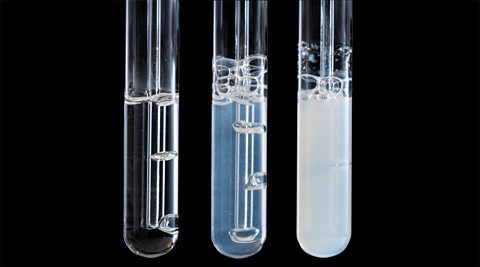Tests for gases
There are several different tests to detect and identify gases and the ionElectrically charged particle, formed when an atom or molecule gains or loses electrons. in compounds. It is important that the test for any gas or ion is unique. The results of a test must let you determine which gas or ion is present, rather being uncertain about which one it is.
Oxygen
Oxygen supports combustionThe process of burning by heat.. If oxygen is present in a test tube, a glowing splint relights when it is held inside.
Hydrogen
Hydrogen ignites in air. If hydrogen is present in a test tube, a lighted splint held near its mouth ignites with a squeaky pop.
Carbon dioxide
Carbon dioxide reacts with calcium hydroxide solution to produce a white precipitate of calcium carbonate. limewaterCalcium hydroxide solution. It turns milky in the presence of carbon dioxide. is a solution of calcium hydroxide. If carbon dioxide is bubbled through limewater, the limewater turns milky or cloudy white.

Chlorine
Chlorine is an acidic gas that also acts as a bleach. Damp litmus paperA type of indicator that can be red or blue. Red litmus turns blue in alkalis, while blue litmus turns red in acids. is bleached white when it is placed in chlorine.
If damp blue litmus paper is used, the paper turns red then white.
Summary
| Test | Observation | Inference |
| Glowing splint held in a test tube | Splint relights | Oxygen is present |
| Lighted splint held in a test tube | Pop sound heard | Hydrogen is present |
| Gas bubbled through limewater | Limewater turns milky or cloudy white | Carbon dioxide is present |
| Damp litmus paper held in a test tube | Paper turns white | Chlorine is present |
| Test | Glowing splint held in a test tube |
|---|---|
| Observation | Splint relights |
| Inference | Oxygen is present |
| Test | Lighted splint held in a test tube |
|---|---|
| Observation | Pop sound heard |
| Inference | Hydrogen is present |
| Test | Gas bubbled through limewater |
|---|---|
| Observation | Limewater turns milky or cloudy white |
| Inference | Carbon dioxide is present |
| Test | Damp litmus paper held in a test tube |
|---|---|
| Observation | Paper turns white |
| Inference | Chlorine is present |